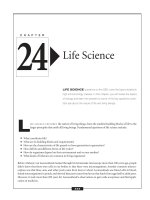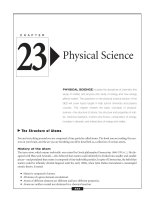About the ged writing exam 6 ppsx
Bạn đang xem bản rút gọn của tài liệu. Xem và tải ngay bản đầy đủ của tài liệu tại đây (98.84 KB, 6 trang )
Capitalization
Capitalization is an important tool to help us identify (1)
the beginning of a new sentence and (2) proper nouns
and adjectives. Here are six rules for correct capitalization:
1. Capitalize the first word of a sentence.
Please close the door.
What are you trying to say?
If you are quoting a full sentence within your
own sentence, use a capital letter, unless you
introduce the quote with that.
The author notes, “A shocking three out of
four students admitted to cheating.”
The author notes that “a shocking three out of
four students admitted to cheating.”
If you have a full sentence within parentheses,
that sentence should be capitalized as well (and
the end punctuation mark should be within the
parentheses).
He was expelled for repeatedly violating the
school’s code of conduct. (He was caught
stealing and cheating several times.)
2. Capitalize proper nouns. A proper noun is the
name of a specific person, place, or thing (as
opposed to a general person, place, or thing). See
the table at the bottom of this page.
3. Capitalize the days of the weeks and months of
the year, but not the seasons.
It was a warm spring day in May.
Wednesday is the first official day of autumn.
4. Capitalize the names of countries, nationalities,
geographical regions, languages, and religions.
He has traveled to Brazil and Tunisia.
She is half Chinese, half French.
She is from the South.
(But, Drive south for five miles.)
We speak Spanish at home.
He is a devout Catholic.
– MECHANICS–
65
CAPITALIZE (SPECIFIC) DON’T CAPITALIZE (GENERAL)
Jennifer Johnson (specific person) the lady
Algebra 101 (specific class) my math class
Main Street (specific street) on the street
Frosted Flakes (specific brand) good cereal
Caspian Sea (specific sea) deep sea/ocean
Lincoln Memorial (specific monument) impressive memorial/monument
S.S. Cole (specific ship) naval carrier
Dade High School (specific school) our high school
Precambrian Age (specific time period) long ago
Microsoft Corporation (specific company) that company
5. Capitalize titles that come before proper names.
Judge Lydia Ng Lydia Ng, judge in the
Fifth District
Professor Lee Chang Lee Chang, professor of
physical science
Vice President Tilda Stanton Tilda Stanton,
vice president
6. Capitalize titles of publications, including
books, stories, poems, plays, articles, speeches,
essays, and other documents, and works of art,
including films, paintings, and musical composi-
tions.
Pablo Picasso’s painting Guernica captures
the agony of the Spanish Civil War.
Read Susan Sontag’s essay “On Photography”
for class tomorrow.
The Declaration of Independence is a sacred
document.
Spelling
As noted earlier, spelling questions on the GED are
limited to homonyms, contractions, and possessives. The
spelling of these words is reviewed below.
Contractions and Possessives
Confusion between contractions and possessives results
in some of the most common spelling mistakes.
Contractions are words that use an apostrophe to show
that a letter or letters have been omitted from the
word(s). Possessive pronouns indicate ownership of
objects and ideas. They do NOT take an apostrophe.
– MECHANICS–
66
POSSESSIVE PRONOUN MEANING EXAMPLE
its belonging to it The dog chased its tail.
your belonging to you Your time is up.
their belonging to them Their words were comforting.
whose belonging to who Whose tickets are these?
CONTRACTION MEANING EXAMPLE
it’s it is It’s time to eat.
you’re you are You’re not going to believe your eyes.
they’re they are They’re getting their tickets now.
who’s who is Who’s going to dinner?
who has Who’s got my tickets?
– MECHANICS–
67
Homonyms
Homonyms are words that sound alike but have different spellings and meanings. Here are some of the most com-
mon homonyms:
accept to take or receive
except leave out
affect (verb) to have an influence
effect (noun) the result or impact of something
all ready fully prepared
already previously
bare (adj) uncovered; (verb) to uncover
bear (noun) animal; (verb) to carry or endure
brake (verb) to stop; (noun) device for stopping
break (verb) to fracture or rend; (noun) a pause or temporary stoppage
buy (verb) to purchase
by (preposition) next to or near; through
desert (noun) dry area; (verb) to abandon
dessert sweet course at the end of a meal
every day each day
everyday ordinary; daily
hear (verb) to perceive with the ears
here (adverb) in this place
know to understand, be aware of
no negative—opposite of yes
loose (adj) not tight; not confined
lose (verb) to misplace; to fail to win
may be might be (possibility)
maybe perhaps
morning the first part of the day
mourning grieving
passed past tense of pass (to go by)
past beyond; events that have already occurred
patience quality of being patient; able to wait
patients people under medical care
personal (adj) private or pertaining to the individual
personnel (noun) employees
presence condition of being
presents gifts
principal most important; head of a school
principle fundamental truth
right correct; opposite of left
rite ceremony
write produce words on a surface
scene setting or view
seen past participle of see
than used to compare (he is taller than I)
then at that time, therefore (first this, then that; if you think it’s good, then I’ll do it)
their possessive form of they
there location; in that place
through in one side and out the other; by means of
threw past tense of throw
to (preposition) in the direction of
too (adverb) in addition; excessive
two number
waist part of the body
waste (verb) to squander; (noun) trash
weak feeble
week seven days
weather climatic conditions
whether introducing a choice
which what, that
witch practitioner of witchcraft
– MECHANICS–
68
O
n the GED Language Arts, Writing Test,questions about organization are designed to measure your
ability to organize ideas effectively.You may be asked to identify the best sequence of sentences or para-
graphs, the best place to move a sentence or paragraph, or the best sentence or paragraph to eliminate
to improve a paragraph’s unity or coherence.
This section reviews three aspects of organization:
1. essay structure and organizational patterns
2. effective paragraphs
3. transitions
Essay Structure and Organizational Patterns
Most nonfiction texts have the basic underlying structure of main idea → support. They begin with a main idea (some-
times called the thesis or theme of the text) that controls the whole passage. It is this idea that the text will develop.
The rest of the text then provides support for that idea in the form of examples, definitions, reasons, and so on. Most
paragraphs function this way, too. In fact, you can think of a paragraph as a mini-essay.
69
CHAPTER
9
Organization
THE LANGUAGE Arts, Writing Test includes questions about
organization: how ideas are arranged in a text. This chapter reviews
key strategies and patterns that writers use to effectively organize their
ideas.
On this basic level of main idea → support, every-
thing in the passage or paragraph should support or
develop that main idea. When sentences or paragraphs
lose focus or stray from that controlling idea, the passage
or paragraph loses its effectiveness.
Writers can use several different strategies for organ-
izing their support. One of these strategies often serves as
the overall organizing principle for the text, while indi-
vidual sections may use other techniques as well. For
example, imagine an essay comparing and contrasting
two film versions of Frankenstein. The support will be
organized by comparison and contrast. But the writer
may also use other organizational techniques within that
comparison and contrast structure. For example, he or
she may use order of importance when explaining what
makes one version better than the other.
The four most common organizational patterns are:
1. chronological order
2. order of importance
3. comparison and contrast
4. cause and effect
To answer many of the questions about organization
on the GED, you will need to be able to determine the
writer’s purpose and to recognize organizational patterns
on both the essay and paragraph levels. By identifying the
organizational pattern, you can determine where to
insert sentences or paragraphs and whether any sen-
tences or paragraphs are misplaced, such as a sentence
that is out of chronological order.
Chronological Order
When writers use time as their main organization prin-
ciple, it is called chronological order. They describe events
in the order in which they did happen, will happen, or
should happen. Much of what you read is organized in
this way, including historical texts, instructions and pro-
cedures, and essays about personal experiences.
Passages organized by chronology typically use a lot of
transitional words and phrases to help us follow the pas-
sage of time. The transitions help us see when things
happened and in what order. They help us follow along
when the passage shifts from one period of time to
another. Transitional words and phrases keep events
linked together in the proper order. (Transitions are cov-
ered in more detail on page 72.)
The following is a list of some of the most common
chronological transitions:
first, second, third, etc. before
after next now
then when as soon as
immediately suddenly soon
during while meanwhile
later in the meantime at last
eventually finally afterward
The third paragraph of the Batman text from page 30
uses this organizational pattern. The transitions are
underlined:
Kane’s Batman was a big success right from the
start. The masked hero s
oon moved from comic
books to its own newspaper strip, and in 1943
,Bat-
man episodes were aired on the radio. In 1966,live-
action Batman shows hit the TV screen. The series
was wildly popular, and the syndicated show st
ill
airs today on channels like the Cartoon Network.
Order of Importance
With this organizational pattern, ideas are arranged by
rank instead of time. What’s most important comes first
or last, depending upon the writer’s purpose.
Organizing ideas from most important to least
important puts the most essential information first.
Many writers do this when they are offering advice or
when they want to be sure readers get the most impor-
tant information right away. Newspaper articles, for
example, generally use this structure. They begin with
the most important information (the who, what, when,
where, and why of the event) so readers don’t have to
read the whole article to get those key facts. Details and
background information come later in the article.
When writers move from least to most important,
they save their most important idea or piece of infor-
mation for last. Writers often use this approach when
they are presenting an argument. That’s because this
kind of structure is usually more convincing than the
most-to-least organizational pattern. The more contro-
versial the argument, the more important this structure.
– ORGANIZATION–
70









